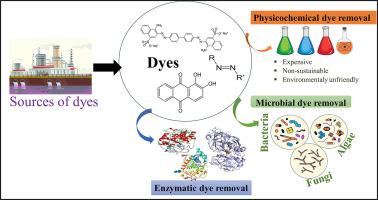A review of dye biodegradation in textile wastewater, challenges due to wastewater characteristics, and the potential of alkaliphiles
IF 5.4
Q2 ENGINEERING, ENVIRONMENTAL
引用次数: 0
Abstract
Thousands of synthetic dyes are used in the textile industry for fabric manufacturing. During the dyeing process, more than one-third of the dyes are not absorbed by the fabric and end up in wastewater. These dyes are toxic and carcinogenic, leading to significant environmental pollution, diminishing the aesthetic value of natural water bodies and posing threats to human health and aquatic biodiversity. Physicochemical treatment methods have been used to remove dyes but are neither economically feasible nor environmentally friendly. In contrast, biological treatment methods are cost-effective, efficient, and environmentally sustainable. This review aims to provide a comprehensive overview of textile dye biodegradation, the challenges posed by the characteristics of textile wastewater, and the potential of alkaliphilic microbes to address this issue. Additionally, it discusses the underlying mechanisms of dye biodegradation, the advantages of mixed cultures or microbial consortia over single microorganisms in dye degradation, and the factors affecting the degradation efficiency of microorganisms. Dye concentration and type, incubation temperature, pH, and time are identified as influential factors in the dye biodegradation process. Studies confirm that the standard biological treatment process using non-alkaliphilic microorganisms is ineffective for complete dye degradation and detoxification, as textile wastewater is alkaline and saline in nature. Therefore, alkaliphilic microbes are a potential alternative for textile dye wastewater treatment. These microorganisms can function under extreme conditions and produce various oxidoreductive enzymes, including azoreductase, laccase, lignin peroxidase, and manganese peroxidase, which can be involved in the biodegradation process. Alkaliphilic microbes play a crucial role in dye biodegradation through their alternative metabolic pathways and adaptive response mechanisms, enabling them to survive under harsh conditions and making them highly efficient. Although these microbes have been studied in laboratory and pilot-scale experiments, further research is needed to assess their practicality in real-world applications.

综述纺织废水中染料的生物降解、废水特性带来的挑战以及嗜碱性生物的潜力
纺织业使用数千种合成染料制造织物。在染色过程中,超过三分之一的染料没有被织物吸收,最终进入废水。这些染料具有毒性和致癌性,会造成严重的环境污染,降低天然水体的美学价值,并对人类健康和水生生物多样性构成威胁。物理化学处理方法已被用于去除染料,但既不经济也不环保。相比之下,生物处理方法具有成本效益、高效率和环境可持续性。本综述旨在全面概述纺织染料的生物降解、纺织废水特性带来的挑战以及嗜碱性微生物解决这一问题的潜力。此外,本文还讨论了染料生物降解的基本机制、混合培养物或微生物联合体在染料降解方面比单一微生物的优势,以及影响微生物降解效率的因素。染料浓度和类型、培养温度、pH 值和时间被认为是染料生物降解过程中的影响因素。研究证实,使用非嗜碱性微生物的标准生物处理工艺无法有效实现染料的完全降解和解毒,因为纺织废水的性质是碱性和含盐的。因此,嗜碱性微生物是纺织染料废水处理的潜在替代品。这些微生物可在极端条件下发挥作用,并产生各种氧化还原酶,包括偶氮还原酶、漆酶、木质素过氧化物酶和锰过氧化物酶,这些酶可参与生物降解过程。嗜碱微生物通过其替代代谢途径和适应性反应机制,在染料生物降解过程中发挥着至关重要的作用,使它们能够在恶劣的条件下生存,并具有很高的效率。虽然在实验室和中试规模的实验中对这些微生物进行了研究,但还需要进一步的研究来评估它们在实际应用中的实用性。
本文章由计算机程序翻译,如有差异,请以英文原文为准。
求助全文
约1分钟内获得全文
求助全文
来源期刊

Journal of hazardous materials advances
Environmental Engineering
CiteScore
4.80
自引率
0.00%
发文量
0
审稿时长
50 days
 求助内容:
求助内容: 应助结果提醒方式:
应助结果提醒方式:


